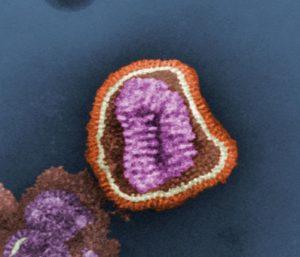
Negative-stained (Pseudocolored) transmission electron micrograph (TEM) depicts the ultrastructural details of an influenza virus particle, or “virion”. Photocredit Frederick Murphy. (Public Health Image Library/ CDC, ID#10073)
High antibody titres, specifically high hemagglutinination inhibition (HI) is a major criteria driving the licensure of egg-based inactivated influenza vaccines. The European Medicines Agency Committee for Medical Products for use (CHMP) requires influenza vaccine induced antibody immunity to have 70% seroprotective rate, 40% serconversion rate and 2.5 geometric mean fold rise for it to be approved for license. Monitoring of cell mediated immunity, has not been included in the CHMP requirements, despite research showing the importance of cell mediated immunity in cross protection and long term immunity against influenza.
Development of egg-based influenza vaccines present many challenges, including limited manufacturing capacity, as well as poor induction of cell mediated immunity by egg-based vaccines. Plant-made monovalent vaccine like particles (VLP) are a favourable replacement as the vaccine can be mass produced quickly. In addition, Plant-made VLP presenting hemagglutinin proteins H1 or H5, have been shown to induce reactive CD4+ T cells responses.
Researchers lead by Nathalie Laudry (Medicago Inc.) compared humoural and cell mediated immunity induced by HV5VLP (plant-made) co-adminstrered with varying doses of Alhydrogel® (H5VLP-alum) or glucopyranosyl lipid adjuvant-stable emulsion (H5VLP-GLASE) in dose finding Phase 2 clinical trial. H5VLP-GLASE even at a low dose of 3.5μg vaccine met CHMP requirements. Despite inducing significantly higher antibody titres, than previously recorded H5VLP-alum did not achieve the required CHMP criteria even at a high vaccine dose of 20μg, as it failed to induce the minimum required seroprotection rate.
All comparator vaccines except the 7.5μg H5VLP-GLASE induced robust short term T cell responses (21 days post final vaccination). However, only the 10μg H5VLP-alum vaccine (lowest dose) was able to maintain induced immunity 5 months post last vaccination. Despite detecting very low cytokine responses, all tested vaccines induced low but detectable central memory responses, that were able to co-produce IL-2+TNF-α+ cytokines. Only the 10μg H5VLP-alum vaccine induced detectable effector memory cells with a IL-2+TNF-α+ cytokine expression profile.
Overall H5VLP-alum induced robust and long term T cell immune responses that were superior to the H5VLP-GLASE vaccines. However, the ability of H5VLP-GLASE to induce antibody responses that passed the CHMP criteria and low but detected cell mediated immunity, makes it a more favourable vaccine. Thus future research could potentially focus on improving the cell mediated immunity profile induced by H5VLP-GLA-SE.
Journal Article: Pillet et al., 2018. Humoral and cell-mediated immune responses to H5N1 plant-made virus-like particle vaccine are differentially impacted by alum and GLA-SE adjuvants in a Phase 2 clinical trial. NPJ Vaccines.
Article by Cheleka AM Mpande











